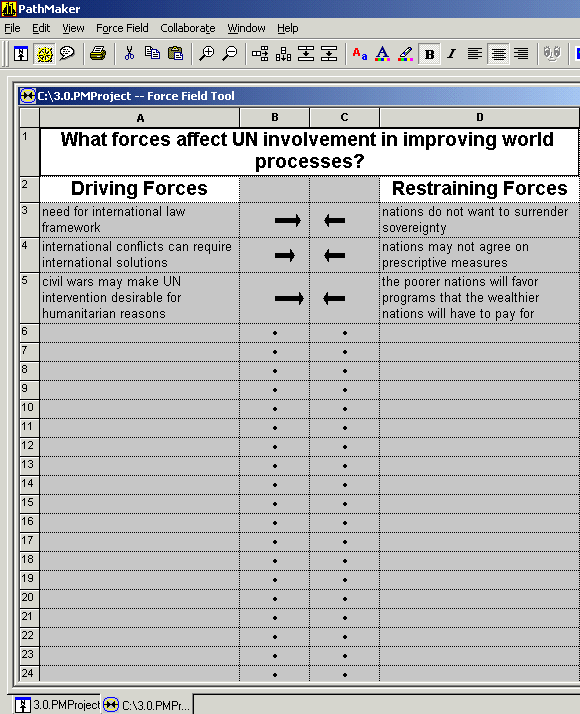Force Field Analysis
Force Field Analysis is a simple but powerful technique for building an understanding of the forces that will drive and resist a proposed change. It consists of a two column form, with driving forces listed in the first column, and restraining forces in the second.
The force field diagram is derived from the work of social psychologist Kurt Lewin. According to Lewin’s theories, human behavior is caused by forces – beliefs, expectations, cultural norms, and the like – within the "life space" of an individual or society. These forces can be positive, urging us toward a behavior, or negative, propelling us away from a behavior. A force field diagram portrays these driving forces and restraining forces that affect a central question or problem. A force field diagram can be used to compare any kind of opposites, actions and consequences, different points of view, and so on.
In the context of process improvement, driving forces could be seen as pushing for change while restraining forces stand in the way of change. A force field diagram is used to analyze these opposing forces and set the stage for making change possible. Change will not occur when either the driving forces and restraining forces are equal, or the restraining forces are stronger than the driving forces. For change to be possible, the driving forces must overcome the restraining forces. Usually, the most effective way to do this it to diminish or remove restraining forces. It can be tempting to try strengthening the driving forces instead, but this tends to intensify the opposition at the same time.
The balance sheet structure of the force field diagram makes it applicable to situations other than comparing driving and restraining forces as well. For example, you could use it to list possible actions and reactions, compare ideal situations and reality, or in negotiation, weigh what you want from someone with what they would have to face if they agreed.
Setting Up Your Force Field Diagram

- Draw two columns, with one header running across both.
- Write the planned change in the header area.
- Label the left column "driving forces", and the right one "restraining forces".
- List the forces in the two columns.
- Encourage creative but realistic thinking.
- Forces seek equilibrium. To encourage change, create asymmetry between forces.
- Which of the restraining forces can be removed or weakened?
Force Field: Other Uses
You can also use a force field diagram to:
- List pro's and con's.
- List actions and reactions.
- List strengths and weaknesses.
- Compare ideal situations and reality.
- In negotiation, compare the perceptions of opposing parties.
- List "what we know" in the left column, and "what we don't know" in the right.

